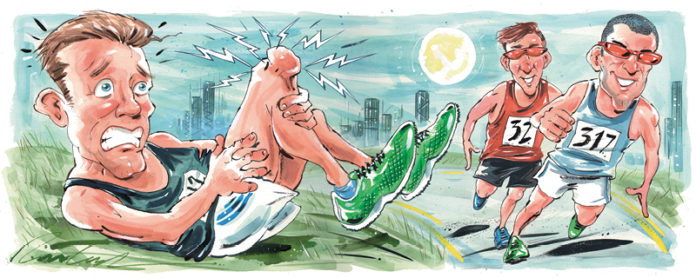
Your knee hurts, but what’s wrong? Your first stop should be your doctor, but go in educated. Here are the most common symptoms to three types of knee pain that could be clues to the source of your pain.
Achy, stiff knee
Many people will experience aching and stiffness in their knee, particularly after sitting for a long time. Once moving, knees feel better as theywarm up. Additionally, they might feel the knee has a crunchy sound when bending. Those are signs of osteoarthritis, which is the result of the loss of the protective tissues (meniscus, articular cartilage and synovial membrane) in the knee joint. With the protection gone and the joint space narrowing, the bones will hit, causing inflammation that results in the aching, stiffness and grinding.
Catching, locking with sharp pain
If you experience sharp pain as the knee seems to lock in place; or a feeling of the knee giving out that is often painful; and you are unable to do a deep squat, especially with a twist, you could be suffering a meniscus tear. The meniscus is two horseshoe-shaped tissues that work as a shock absorber for your knee. More than 30 per cent of people over 50 will experience a meniscus tear due to degeneration of the tissue and there is pain when you touch the top of the joint line of the bone. Many of these injuries can resolve with the right treatment and without surgery.
Running & jumping pain
If your knee hurts after run training and you find climbing stairs especially painful, you could be suffering patella tendinitis, a.k.a. runner’s knee. With each step, the pain comes from the front of the knee below the knee cap. The patella tendon covers the patella and connects to the top of the tibia. Any tendinitis is the micro-tearing of a tendon that leads to inflammation and pain. Patella tendinitis is usually the result of overuse (new use), muscle strength misalignment, or a combination of both. A weak quad and strong hamstring are the most common muscle misalignments associated with patella tendinitis.
The Treatments
Depending on the injury, the treatment goal might be different. For instance, you will not heal and recover from osteoarthritis, but you can slow the progression and reduce the pain. You can fully heal from patella tendinitis. Even though the goals of these treatments are different, the core non-surgical treatments are the same.
-
- Functional Rest: You need to rest, but since we are active people and need to stay active, I prefer functional rest. Functional rest means mechanically protecting the injury with a brace, so you are supporting the joint to reduce the chance of exacerbating the injury.
-
- Reduce Inflammation: Inflammation is a normal response to injury. However, that inflammation is a source of pain and will reduce your range of motion. The combination of cold and compression is proven to reduce inflammation in orthopedic injuries.
-
- Regain Strength & Symmetric Motion: Muscle imbalance and restricted range of motion will create an asymmetry which puts your biomechanics out of alignment. To recover and reduce recurrence and progression, it is important to spend five minutes a day regaining the necessary strength and flexibility.
Any one of these three steps will help. However, like soup with one ingredient, it simply will not taste as good. By combining all three treatments consistently, you will maximize your results.













